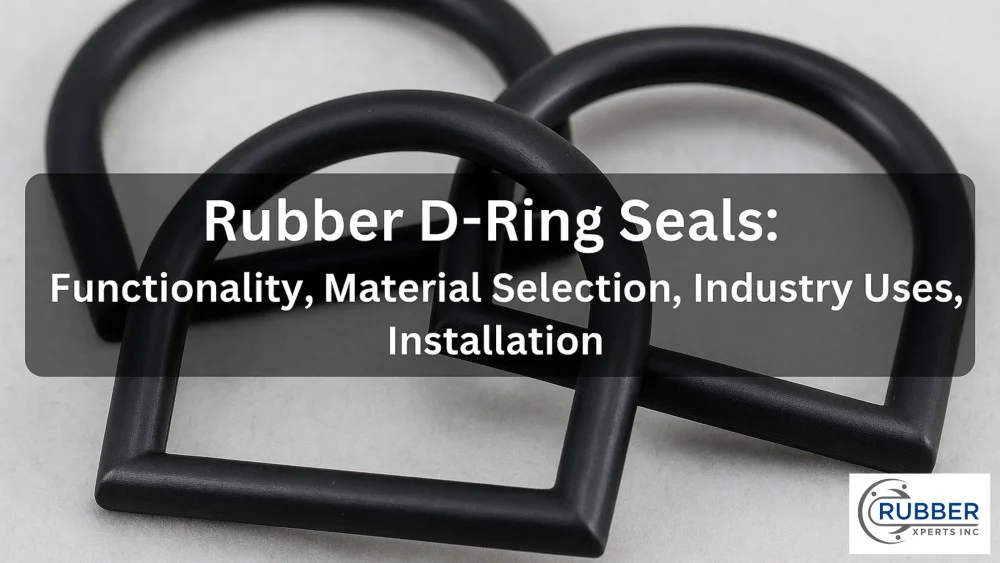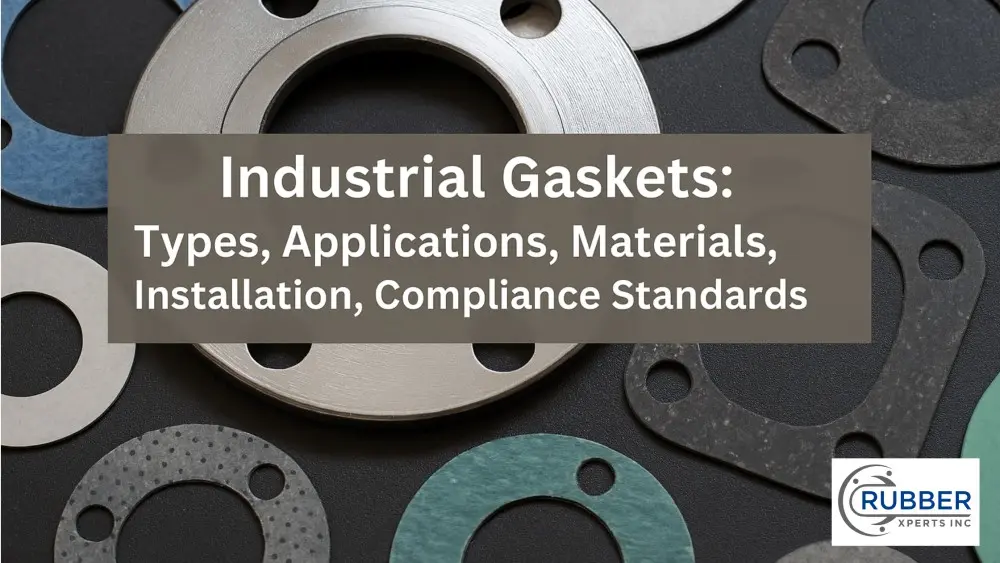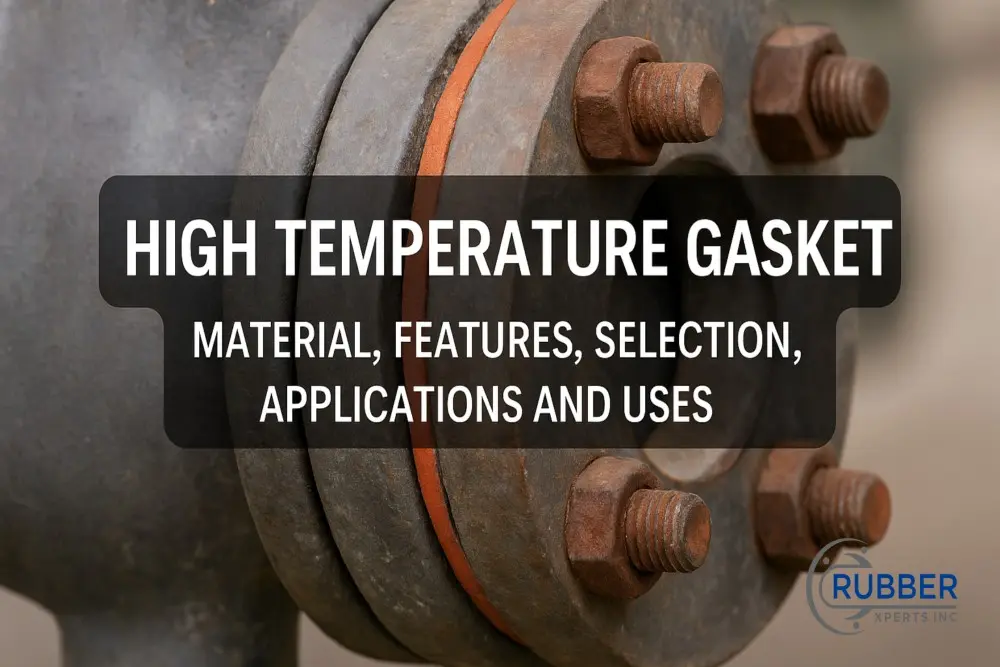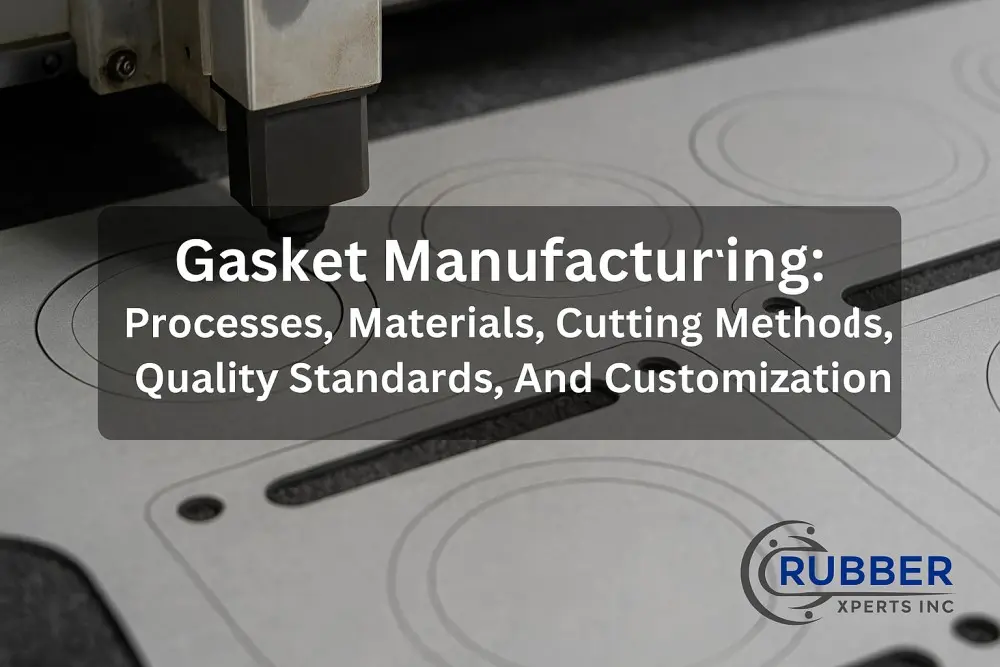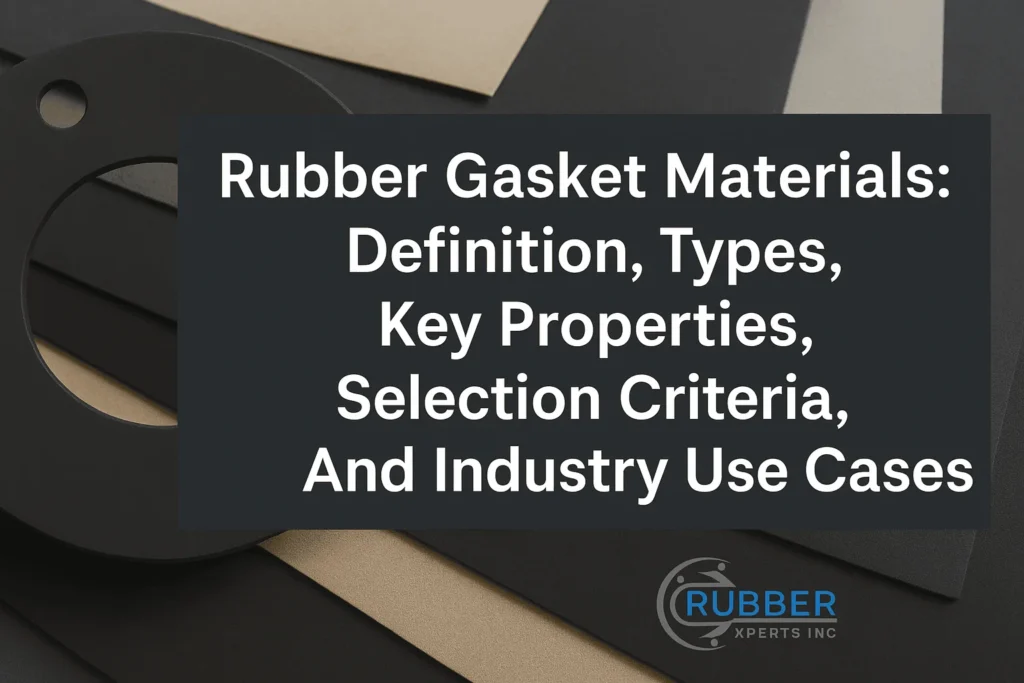Rubber is a highly versatile material used in numerous industries. It is celebrated for its unique flexibility, durability, and resilience. Whether naturally sourced or synthesized from elastomers, rubber products have diverse applications, from automotive essentials like tires and seals to precision-engineered industrial components.
Rubber products range from seals, gaskets, and hoses to more specialized goods like flooring and coatings. These products are designed for specific uses and demonstrate rubber’s adaptability in both industrial and consumer markets.
Rubber products are manufactured using molding, extrusion, vulcanization, and compounding processes. These engineered processes change raw materials into durable and functional components, ensuring that rubber products meet the stringent demands of various industries and tough conditions.
Rubber products are used in the automotive, construction, aerospace, and healthcare industries. Their elasticity, tensile strength, and ability to perform under extreme conditions make them integral for creating reliable industrial components and consumer goods.
The material properties of rubber products, including resilience, tensile strength, and resistance to abrasion and chemicals, are fundamental to their longevity and performance. These characteristics ensure rubber maintains its structural integrity in demanding environments while providing optimal functionality.
The benefits of rubber products include their cost-effectiveness, long-lasting nature, and eco-friendly options. With their ability to absorb shocks, reduce noise, and offer customizability, rubber products are important for industries and consumers seeking efficient and sustainable solutions for diverse applications.
What is a Rubber Product?
A rubber product is an item made from rubber or elastomer that is both flexible and durable. Rubber products are known for returning to their original shape after deformation, making them ideal for various industrial applications. Rubber products are important in industrial sealing due to their excellent sealing properties and ability to form tight, reliable seals that prevent leakage, even in challenging conditions.
Rubber products serve an imperative role by providing flexibility and elasticity, which allows them to conform to irregular surfaces. This ability ensures that rubber products are effective under various pressures and temperatures. The types of rubber used, such as nitrile, silicone, or EPDM, are chosen based on their specific resistance to chemicals, oils, or extreme environments.
The manufacturing process of rubber products involves mixing raw rubber with other materials to improve its properties, followed by shaping and curing. This process, known as vulcanization, involves applying heat and pressure to change the raw rubber into a strong, durable material. The rubber is then molded into its final product form through various techniques such as extrusion, injection molding, or compression molding, ensuring it meets the requirements for flexibility, durability, and sealing capabilities in industrial applications.
The inherent characteristics of rubber products, such as their durability and resistance to wear, make them necessary for preventing leaks. Their versatility in adapting to different conditions and their ability to withstand mechanical stress, combined with their elasticity, ensure that industrial systems remain leak-free, safe, and efficient.
What are the Different Types of Rubber Products?
The different types of rubber products are natural rubber products, synthetic rubber products, seals and gaskets, and hoses and tubes. These rubber products are designed for a variety of industrial and commercial applications, offering flexibility, durability, and resistance to wear and tear. Rubber products are fundamental in various sectors, such as automotive, healthcare, construction, and manufacturing, where materials must perform under pressure, temperature fluctuations, and chemical exposure.
The different types of rubber products are as follows:
Natural Rubber Products
Natural rubber is derived from latex extracted from rubber trees. It is known for its superior elasticity, tensile strength, and resilience. Natural rubber products are important in industries requiring high flexibility and durability. Tires, footwear, and medical devices are common products made from natural rubber. The flexibility of natural rubber makes it ideal for use in high-impact environments where wear and tear occur. These products are also valued for returning to their original shape after stretching or compressing.
Natural rubber is also used in products like rubber bands, balloons, and gaskets. These items require natural rubber for their resilience and elasticity. The high tensile strength of natural rubber ensures that these products endure the pressure and stress they encounter, especially in industrial and automotive applications.
According to a report by Cognitive Market Research, the global natural rubber market size was $19,251.5 million in 2024, with 73% of the consumption used in tire production.
Synthetic Rubber Products
Synthetic rubber is produced using petroleum-based chemicals through a polymerization process. This category includes various types of rubber, such as styrene-butadiene rubber (SBR) and butadiene rubber, each designed for specific applications. Synthetic rubber is commonly used to make industrial rubber products such as automotive, construction, and manufacturing, owing to its effective resistance to heat, oil, and chemicals.
Synthetic rubber is used in seals, hoses, belts, and tires. It offers high durability and exceptional performance under harsh conditions. According to Research Nester, the synthetic rubber market was valued at $24.29 billion in 2024 and is projected to grow by 7.3% to $61.21 billion by 2037.
Synthetic rubber products are also customized to meet specific needs, such as high heat resistance for automotive components or enhanced chemical resistance for industrial gaskets. The broad range of synthetic rubber types allows manufacturers to create products suited for diverse environments, offering superior longevity and performance compared to natural rubber in certain applications.
Seals and Gaskets
Seals and gaskets prevent leakage in many industrial applications, including automotive, plumbing, and machinery. Rubber is the material of choice for these products because of its excellent ability to form tight seals that prevent the escape of gases and liquids. These rubber products are flexible and durable, ensuring they withstand a range of pressures and environmental conditions without degrading over time.
Rubber seals and gaskets are commonly made from natural and synthetic rubber, the choice depending on the application’s unique requirements. Silicone rubber is used in high-temperature environments, while nitrile rubber is preferred for its resistance to oil. The exceptional sealing properties of rubber make it required in industries such as automotive manufacturing and oil and gas.
According to Precedence Research, the global gaskets and seals market was valued at $61.74 billion in 2022 and is projected to grow at a CAGR of 4.08% from 2022 to 2030. This growth reflects the increasing demand for rubber seals and gaskets across various industries, driven by their integral role in maintaining efficiency and preventing leaks in machinery and systems.
Hoses and Tubes
Rubber hoses and tubes are necessary to transport liquids and gases safely in various industries. These products are made from natural and synthetic rubber and are designed to handle high-pressure environments while maintaining flexibility. Rubber hoses are used in applications ranging from automotive fluid systems to industrial machinery.
Rubber hoses and tubes are valued for their ability to withstand extreme temperatures, pressure, and chemical exposure without rupturing or losing functionality. It was projected that the revenue of rubber and plastics hoses and belting manufacturing in the U.S. amounted to approximately $5.27 billion by 2024, according to Statista.
Rubber tubes are used for fluid transfer in agriculture, pharmaceuticals, and food processing industries. They are particularly beneficial because of their flexibility, durability, and resistance to wear and tear. Whether used in hydraulic systems or as medical devices for administering fluids, rubber hoses, and tubes are paramount for smooth operations in industrial and commercial settings.
Mats and Flooring
Rubber mats and flooring offer versatile solutions in industrial and commercial spaces. They provide durable, non-slip surfaces for machinery or foot traffic. These products are made from synthetic or natural rubber and are used in environments requiring shock absorption or sound insulation. Rubber flooring is commonly seen in gyms, factories, kitchens, and warehouses, where its ability to withstand heavy foot traffic and impact is needed.
Rubber mats provide cushioning and support, reducing the risk of injury from slips and falls. They are used in industrial settings to protect workers from fatigue during long hours of standing. Specialty rubber flooring products are also used in areas requiring moisture resistance, such as kitchens or bathrooms, where they help prevent water damage and offer easy maintenance.
According to Transparency Market Research, the global rubber flooring industry was valued at $42.3 million in 2022 and is expected to grow at a CAGR of 6.9% from 2023 to 2031, reaching $77.1 million by the end of 2031. The increasing demand for durable, eco-friendly flooring solutions in various sectors drives this growth.
Rubber Coatings
Rubber coatings are protective layers applied to surfaces to effectively increase their durability and resistance to wear, corrosion, and environmental elements. These coatings are used in the automotive, construction, and electronics industries. Rubber coatings protect components from damage while providing electrical insulation or water resistance. They are particularly useful in protecting metal surfaces from rust and ensuring equipment longevity.
The flexibility of rubber coatings allows them to adapt to the shape and size of the object they coat, ensuring comprehensive protection. These coatings are also weather-resistant, making them suitable for outdoor applications.
Whether for protective coatings on wires or waterproofing construction materials, rubber coatings offer a practical solution for enhancing the performance and lifespan of various products. In 2024, the global silicone rubber insulation coating market was valued at approximately $3.93 billion and is expected to grow to around $6.73 billion by 2034, according to Precedence Research.
Extrusions and Adhesives
Rubber extrusions are used to create various shapes and profiles, which are important in the automotive and construction industries. These custom shapes, made from rubber, help seal gaps, provide insulation, or create structural elements. On the other hand, rubber adhesives are used to bond rubber products to different materials, ensuring a strong and durable connection in a wide range of applications.
Extrusions and adhesives are necessary for applications that require flexibility and strength. Whether for sealing windows in buildings, bonding rubber seals in automotive engines, or protecting electrical components, rubber extrusions and adhesives offer versatility and reliability.
In modern manufacturing processes, rubber extrusions and adhesives play an integral part. According to Market Research Future, the rubber extruder market was valued at $1.6 billion in 2022 and is expected to reach $2.5 billion by 2032, with a projected CAGR of 4.56% from 2024 to 2032. Similarly, the rubber-based adhesive market, valued at $10.5 billion in 2022, is anticipated to grow to $15.8 billion by 2030.
Bushings and Grommets
Bushings and grommets are small rubber components that absorb shocks, reduce friction, and protect wires or cables. Machines use bushings to allow smooth movement between parts, while grommets are used in electrical applications to protect cables from sharp edges. Both are made from rubber types that provide excellent cushioning, flexibility, and durability.
These rubber products prevent wear and tear in mechanical and electrical systems. Bushings and grommets help avoid equipment damage by providing a buffer between moving parts and protecting cables from abrasions. These rubber components contribute to the smooth operation and longevity of industrial machinery and electrical systems by reducing friction and absorbing shocks.
What are the Manufacturing Processes of Rubber Products?
The manufacturing processes of rubber products include molding, extrusion, vulcanization, compounding, and laminating or coating. Each step of rubber processing converts raw rubber into finished products customized for diverse applications.
The manufacturing processes of rubber products are as follows:
Molding
Molding is the process of shaping rubber by placing it into a mold and applying heat and pressure. This method ensures precise designs and dimensions, making it suitable for creating products like seals, gaskets, and tires. Once molded, the rubber undergoes curing to enhance its properties.
The process of rubber molding includes the following types:
- Compression Molding: This method involves placing pre-measured rubber into a heated mold cavity, applying pressure, and allowing it to cure. It’s ideal for simple, high-strength parts.
- Injection Molding: Injection molding involves injecting molten rubber into a mold under pressure, making it suitable for complex shapes and mass production.
- Transfer Molding: In this process, rubber is preheated in a chamber before being forced into the mold, combining efficiency with precision.
Extrusion
Extrusion is a continuous process in which raw rubber is forced through a shaped die to produce hoses, tubes, and profiles. The extruded material is then cured to achieve its final strength and elasticity. Rubber extrusion is favored for its strength to create long, consistent product lengths.
Vulcanization and Calendering
Vulcanization chemically improves rubber’s elasticity and durability by cross-linking its molecular structure through heat and sulfur additives. Calendering, paired with vulcanization, involves rolling rubber into thin sheets or bonding it to fabrics, creating materials for applications like conveyor belts and flooring.
Compounding
Rubber compounding involves mixing raw rubber with additives such as fillers, softeners, and colorants to enhance performance. This step customizes the rubber’s physical properties to specific industrial requirements, such as flexibility, tensile strength, and resistance to heat or chemicals.
Laminating and Coating
Laminating and coating add layers of rubber to other surfaces, such as fabrics or metals, to improve durability, water resistance, or insulation. This process is commonly used in fabricating protective coverings, adhesives, and specialty industrial products.
What is the Main Raw Material Used for Rubber Products Manufacturing?
The main raw materials for rubber products manufacturing include natural rubber, synthetic rubber, and various additives like fillers, plasticizers, and curing agents. Natural rubber, derived from the latex of rubber trees, provides elasticity and tensile strength, while synthetic rubber, created from petrochemical derivatives, offers durability and chemical resistance.
Additives improve performance, customizing the rubber for specific industrial applications. These raw materials form the foundation for producing everything from tires to seals and gaskets.
What is the Spreading Process in Rubber Goods Manufacturing?
The spreading process in rubber goods manufacturing involves applying rubber compounds to surfaces like textiles, metal sheets, or plastics to create a uniform coating or laminated material. Spreading machines evenly distribute rubber, ensuring precision in thickness and adhesion.
Rubber spreading creates waterproof materials, conveyor belts, and insulating layers. By enriching the substrate’s characteristics, the spreading process ensures the durability and functionality of rubber-coated products.
Is Rubber Spinning Also a Manufacturing Process for Rubber Products?
Yes, rubber spinning is also a manufacturing process for rubber products like cylindrical or tubular rubber items. This technique involves rotating rubber around a mandrel or mold while applying pressure and heat. Rubber spinning is normally employed to produce hoses, gaskets, and vibration-dampening components. Its precision makes it ideal for applications requiring smooth, uniform products with consistent wall thickness.
What are the Applications of Rubber Products?
The applications of rubber products are prevalent in automotive, industrial, aerospace and military, consumer goods, medical, construction, and electronics industries. Rubber products like seals, gaskets, hoses, and tires serve specific functions in these fields, providing durability, flexibility, and reliability.
The applications of rubber products are as follows:
Automotive Industry
The automotive industry is one of the largest users of rubber products, particularly for tires, seals, belts, and hoses. Tires, made from both natural and synthetic rubber, provide the necessary grip, durability, and resistance to wear for various driving conditions. Rubber seals and gaskets prevent fluid leakage in engines and transmissions, while rubber belts ensure smooth operation in power transfer systems.
Rubber hoses carry fluids like fuel, oil, and coolant, ensuring efficient vehicle performance. IMARC Group estimated that the global automotive rubber-molded components market will be valued at $57.4 billion in 2024. Specialty rubber types, such as EPDM, add weather and heat resistance, making these products durable in diverse environments.
Industrial Applications
Rubber products are fundamental in the manufacturing, mining, and energy industries, where durability and flexibility are important. Industrial-grade rubber conveyor belts efficiently transport heavy materials in mining and production plants. Rubber vibration dampeners minimize noise and wear in machinery, improving operational longevity.
Seals and gaskets, crafted from specialty elastomers, prevent leaks in hydraulic and pneumatic systems. These products are integral to maintaining safety and efficiency in industrial operations. The U.S. industrial rubber market, bolstered by automation advancements, continues to grow as industries demand high-performance solutions.
According to Future Market Insights, the U.S. industrial rubber products market was valued at $113.7 billion in 2023 and is expected to grow significantly, reaching $214.7 billion by 2033. As of 2024, 1,167 businesses were operating in the rubber product manufacturing industry across the United States.
Aerospace and Military Applications
The aerospace and military sectors heavily utilize rubber products due to their ability to withstand extreme conditions. Rubber O-rings and seals ensure leak-proof performance in fuel systems and hydraulic components. Silicone and fluorocarbon rubber provide resistance to high temperatures and harsh chemicals.
In military applications, rubber linings protect fuel tanks from corrosion, while vibration isolators improve vehicle and equipment performance. These products are compulsory in maintaining operational safety and efficiency. The U.S. aerospace industry, a global leader, relies on rubber solutions for challenging applications, ensuring reliability in the most demanding environments.
According to Cognitive Market Research, the global Aerospace Industry Semi-Finished Rubber Materials market is set to grow at a CAGR of 5.20% from 2023 to 2030. North America dominated the market in 2023, accounting for over 40% of global revenue, with an anticipated CAGR of 3.4%. South America held more than 5% of the global revenue and is expected to grow at a CAGR of 4.6% during the same period.
Consumer Goods
Rubber is fundamental in consumer products, from footwear and mats to sports equipment. Natural rubber is used in shoe soles for comfort and shock absorption, while synthetic rubber is preferred for high-performance sports goods like balls and grips. Rubber mats improve safety in homes and workplaces by offering slip resistance and cushioning.
These products combine functionality with style, making them indispensable in daily life. The U.S. consumer goods market continues to innovate with rubber-based solutions, meeting the demands of modern lifestyles. According to IBIS World, there are 1,167 rubber product manufacturing businesses in the US as of 2024.
Medical Applications
Rubber products are integral to the medical field, with applications such as surgical gloves, catheters, and tubing. Silicone rubber, known for its biocompatibility, is widely used in devices that contact bodily fluids. Surgical gloves provide hygiene and protection for healthcare professionals, while tubing facilitates fluid transfer in pressing medical procedures.
The durability and flexibility of rubber products ensure their reliability in life-saving applications. The U.S. medical rubber market is expanding, driven by advancements in healthcare technology and an increasing need for safe, durable materials.
The medical technology industry was valued at $488.98 billion in 2021, reflecting its rapid growth. According to Global Growth Insights, the medical-grade silicone rubber market was worth $734.76 million in 2023 and is projected to increase to $779.88 million by 2024.
Construction Industry
The construction industry relies on rubber products for their durability, flexibility, and environmental benefits. Rubber flooring, for example, is slip-resistant, sound-absorbing, and ideal for high-traffic areas. Seals and gaskets ensure airtight and watertight connections in plumbing and HVAC systems, preventing leaks and enhancing energy efficiency.
Sustainable rubber materials, such as recycled rubber, are increasingly used in modern construction projects. In the U.S., the demand for eco-friendly infrastructure has boosted the adoption of rubber products, supporting the industry’s growth and environmental goals.
Electronics and Electrical Applications
Rubber products, such as insulation materials, gaskets, and protective covers, are important in electronics. Silicone rubber, with its excellent heat resistance, insulates cables and wires, ensuring safety and functionality. Rubber gaskets protect sensitive electronic components from dust, moisture, and vibrations.
The demand for reliable rubber solutions has increased as the U.S. electronics market grows. These products protect and enhance the performance of modern electronic devices, supporting technological advancements.
What are the Material Properties of Rubber Products?
The material properties of rubber products are hardness, tensile strength, resilience, and compression set. These properties determine rubber’s versatility in numerous industries, from automotive to construction.
The material properties of rubber products are as follows:
Hardness
Hardness refers to a rubber’s resistance to deformation when subjected to force. Measured on the Shore A scale, it helps determine the suitability of rubber for products like seals, gaskets, and tires, where rigidity and structural integrity are necessary. Higher hardness ensures durability under heavy loads, while lower hardness offers flexibility, making it ideal for softer applications like cushioning.
Tensile Strength
Tensile strength quantifies a rubber’s ability to withstand pulling forces before breaking. This property is necessary for products like conveyor belts, elastic bands, and industrial hoses, ensuring they endure stretching and heavy-duty use without failure. Rubber with high tensile strength is particularly valuable in demanding environments, such as manufacturing or mining, where performance under extreme stress is required.
Resilience
Resilience is the ability of rubber to recover its original shape and function after being stretched, compressed, or deformed under stress. This characteristic is important for maintaining the longevity and performance of rubber products across various applications. Resilience ensures rubber components endure repetitive stress and environmental challenges without permanent damage.
Resistance
Rubber resistance is its ability to withstand various environmental and mechanical stresses without losing functional integrity. This property ensures the durability and reliability of rubber products across industries. Rubber seals and gaskets resist deformation under pressure, while tires endure continuous contact with abrasive surfaces.
The types of rubber resistance are as follows:
- Tear: Rubber’s tear resistance prevents damage from sharp forces or high-stress applications. This property is required for heavy-duty products like industrial belts and gaskets, ensuring extended lifespan.
- Abrasion: This characteristic allows the rubber to endure surface wear caused by repeated friction. Tires and conveyor belts need to be exposed to constant movement and pressure.
- Temperature: Rubber withstands extreme heat and cold, maintaining flexibility and performance in harsh conditions. For example, silicone rubber is widely used in automotive and aerospace applications for its thermal stability.
- Flame: Flame-retardant rubber materials resist ignition and minimize fire hazards. Products like neoprene are commonly used in construction and electrical applications for enhanced fire safety.
- Chemical: Rubber’s resistance to oils, acids, and solvents ensures its functionality in corrosive environments. This property is particularly valuable in the oil and gas industry, where rubber components like hoses and seals are exposed to chemicals.
Compression Set
The rubber set’s compression measures its capacity to return to its original shape after prolonged compression. This property is necessary for seals, gaskets, and other components requiring consistent pressure performance. A low compression set indicates superior material quality, ensuring leak-proof seals and reliable operation in automotive, industrial, and aerospace applications.
What are the Benefits of Rubber Products?
The benefits of rubber products include durability, elasticity, low maintenance, vibration reduction, insulation, cost-effectiveness, customizability, and biodegradability. These benefits make rubber products versatile and sustainable solutions in various industries.
The benefits of rubber products are as follows:
Durability
Rubber is known for its exceptional durability, particularly in harsh conditions. This makes it ideal for products like tires, hoses, and conveyor belts, where long-lasting performance is important. Rubber’s resistance to wear, weathering, and environmental damage ensures that these products maintain their functionality over time, minimizing the need for frequent replacements and reducing operational downtime.
Elasticity and Flexibility
Rubber is inherently elastic, stretching and returning to its original shape. This quality benefits products like seals, gaskets, and shock absorbers, which must withstand constant compression, expansion, or movement. Rubber’s flexibility allows these products to cushion impacts effectively, absorb shocks, and maintain their sealing properties, ensuring reliable performance across various applications.
Low Maintenance
Rubber products are relatively easy to maintain, especially when compared to materials prone to corrosion or damage from external factors. For example, rubber flooring or seals require minimal upkeep, making them highly cost-efficient for residential and commercial use. Their resistance to environmental factors like moisture, chemicals, and extreme temperatures ensures they remain functional and visually appealing for extended periods without significant maintenance.
Vibration and Noise Reduction
Rubber’s ability to absorb vibrations and reduce noise makes it an excellent material for applications where noise reduction and comfort are important. Rubber mounts, bushings, and vibration isolators are commonly used in machinery, automotive, and building construction. These rubber products minimize the transmission of vibrations, reduce noise levels, enhance comfort, and protect sensitive equipment from damage, resulting in improved operational efficiency and safety.
Insulation
Rubber is a great insulator against heat, electricity, and sound. It is used in electrical cables, connectors, and protective coverings to prevent electrical hazards and ensure safety in various industries, including construction, automotive, and telecommunications. Rubber’s insulating properties help maintain temperature control, prevent electrical shorts, and protect against environmental damage, making it an important material in electrical systems.
Cost-Effective
Rubber products are highly cost-effective due to their durability, ease of manufacturing, and versatility. Synthetic rubber, in particular, offers an affordable alternative to natural rubber for industrial uses, providing long-lasting solutions without high production costs. This makes rubber products an economical choice for industries that require high-performance materials at a lower price, such as automotive, construction, and manufacturing.
Customizability
Rubber is molded into nearly any shape, making it highly customizable for specific applications. This is advantageous for automotive, medical, and construction industries, where specialized components like rubber seals, gaskets, and hoses are required. Custom rubber products are designed to meet precise dimensional, performance, and environmental specifications, ensuring they fit the intended use perfectly.
Biodegradability
Natural rubber is biodegradable, making it more eco-friendly than synthetic alternatives. As environmental concerns grow, the ability of rubber to break down over time offers a sustainable benefit, particularly in products like rubber flooring, tires, and rubber-based adhesives. This eco-friendly characteristic aligns with the increasing demand for sustainable manufacturing processes and products in industries focused on reducing their carbon footprint.
Why Use Rubber Products?
Use rubber products because they offer a unique combination of durability, flexibility, and resistance, making them ideal for various applications. Rubber products are designed to withstand harsh environments, absorb shock, and maintain functionality over time.
The versatility of rubber products allows for customization to meet specific needs in industries such as automotive, construction, and medical. Rubber products are also cost-effective, low-maintenance, and eco-friendly. These benefits make them a practical and sustainable choice for both industrial and consumer needs.
What are the Most Popular Rubber Products?
The most popular rubber products include gaskets, seals, hoses, belts, and tires. These rubber products ensure optimal performance, safety, and efficiency in automotive, industrial machinery, and construction applications.
The most popular rubber products are as follows:
- Gaskets: Gaskets create a seal between two surfaces, preventing leaks and ensuring airtight or watertight connections in engines, machinery, and appliances.
- Seals: Seals are common in automotive and industrial applications. They are designed to prevent the entry of contaminants and the leakage of fluids.
- Hoses: Rubber hoses are widely used in industries like agriculture and automotive for fluid and gas transportation due to their flexibility and resistance to wear and tear.
- Belts: Rubber belts are integral to machinery, providing a reliable connection between motors and operational parts in industries such as manufacturing and automotive.
- Tires: Rubber tires are fundamental in the automotive industry, providing traction, durability, and vehicle safety.
- Rubber Sheets: Rubber sheets are used for insulation and as a protective barrier in industrial and commercial settings. They are durable and versatile.
- Rubber Matting: These are used in commercial and industrial environments to prevent slips, absorb shocks, and protect surfaces.
- O-rings: Rubber O-rings are commonly used in sealing applications, especially in hydraulic and pneumatic systems, ensuring leak-proof seals.
- Rubber Molding Products: These are custom-designed rubber parts used in various automotive and consumer goods applications.
- Rubber Coatings: Applied to protect products from environmental damage, rubber coatings are used in industries like construction and electronics.
What Industries Rely on Rubber Products?
Industries that rely on rubber products include automotive, manufacturing, aerospace, medical, and construction. These industries use rubber for a variety of applications, from sealing to insulation, ensuring both product functionality and safety. Rubber products enhance performance in necessary equipment and machinery, making them indispensable in daily operations across these sectors.
The following are the industries that rely on rubber products:
- Automotive Industry: Rubber is integral to the automotive industry, with products like tires, seals, gaskets, and hoses required for vehicle safety, performance, and comfort. Tires from durable rubber compounds offer excellent traction and wear resistance, while seals and gaskets prevent leaks and ensure environmental protection. Rubber hoses contribute to fluid and air circulation, enhancing vehicle efficiency.
- Manufacturing: Rubber products are important, particularly in manufacturing belts, conveyor systems, and machinery components. Rubber conveyor belts transport materials smoothly and efficiently in factories, while machinery components such as rubber seals and gaskets help prevent leaks and ensure long-lasting performance. Rubber’s durability and flexibility make it a go-to material for numerous industrial applications.
- Aerospace: Rubber products like seals, gaskets, and O-rings are important for maintaining pressure and ensuring safety in extreme aerospace environments. These rubber components are used in aircraft engines, fuselage joints, and fuel systems to prevent air or fluid leaks, ensuring optimal performance and safety. The aerospace industry’s reliance on rubber products is growing, as rubber’s ability to withstand temperature extremes and pressure is important for ensuring reliable, high-performance aircraft.
- Medical: Rubber products are indispensable in the medical industry to ensure safety, flexibility, and hygiene. Medical gloves, seals, and tubing are commonly used in healthcare settings, protecting against contaminants and ensuring the smooth delivery of medications and fluids. Rubber’s versatility in medical equipment extends to its use in prosthetics, medical devices, and examination tools, where flexibility and durability are integral.
- Construction: Rubber is paramount in the construction industry and is used in flooring, seals, and protective coatings. Rubber flooring provides durability, impact resistance, and comfort in high-traffic areas, while seals and gaskets improve energy efficiency and weatherproofing in buildings. Rubber coatings offer corrosion resistance, making them a popular choice for both commercial and residential construction projects.
Does Rubber Products Require Maintenance after Installation?
Yes, rubber products require maintenance after installation. While they are durable and long-lasting, regular inspection and upkeep are necessary to ensure the optimal performance of rubber products. Over time, rubber products experience wear and tear due to environmental factors such as temperature fluctuations, UV exposure, and moisture. Proper maintenance involves cleaning, lubricating, and replacing worn parts to ensure they continue to function effectively, particularly in applications like seals, gaskets, and hoses.
Where to Get Customized Rubber Products?
You can get customized rubber products through specialized manufacturers that offer a wide range of high-quality rubber solutions. They specialize in manufacturing and customizing products to meet specific requirements for various industries, from automotive to medical. The expertise of a reliable rubber manufacturer ensures that the customized products meet your applications’ exact specifications, durability, and performance standards.

